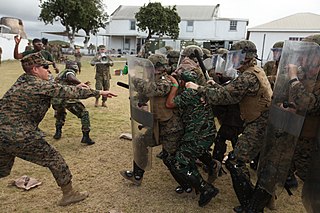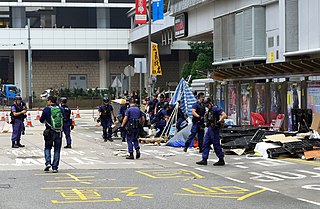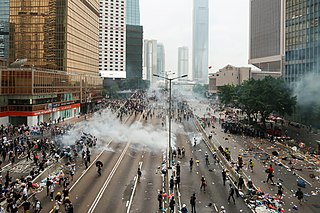
Non-lethal weapons, also called nonlethal weapons, less-lethal weapons, less-than-lethal weapons, non-deadly weapons, compliance weapons, or pain-inducing weapons are weapons intended to be less likely to kill a living target than conventional weapons such as knives and firearms with live ammunition. It is often understood that unintended or incidental casualties are risked wherever force is applied, but non-lethal weapons try to minimise the risk of casualties as much as possible. Non-lethal weapons are used in policing and combat situations to limit the escalation of conflict where employment of lethal force is prohibited or undesirable, where rules of engagement require minimum casualties, or where policy restricts the use of conventional force. These weapons occasionally cause serious injuries or death; the term "less-lethal" has been preferred by some organizations as it describes the risks of death more accurately than the term "non-lethal", which some have argued is a misnomer.
Pepper spray, oleoresin capsicum spray, OC spray, capsaicin spray, or capsicum spray is a lacrimator product containing the compound capsaicin as the active ingredient that irritates the eyes to cause burning and pain sensations, and temporary blindness. Pepper spray is used as a less lethal weapon in policing, riot control, crowd control, and self-defense, including defense against dogs and bears. Its inflammatory effects cause the eyes to close, temporarily taking away vision. This temporary blindness allows officers to more easily restrain subjects and permits people in danger to use pepper spray in self-defense for an opportunity to escape. It also causes temporary discomfort and burning of the lungs which causes shortness of breath.

The compound 2-chlorobenzalmalononitrile (also called o-chlorobenzylidene malononitrile; chemical formula: C10H5ClN2), a cyanocarbon, is the defining component of tear gas commonly referred to as CS gas, which is used as a riot control agent.

A water cannon is a device that shoots a high-velocity stream of water. Typically, a water cannon can deliver a large volume of water, often over dozens of meters. They are used in firefighting, large vehicle washing, riot control, and mining. Most water cannons fall under the category of a fire monitor.

Riot control measures are used by law enforcement, military, paramilitary or security forces to control, disperse, and arrest people who are involved in a riot, unlawful demonstration or unlawful protest.

CR gas or dibenzoxazepine (chemical name dibenz[b,f][1,4]oxazepine, is an incapacitating agent and a lachrymatory agent. CR was developed by the British Ministry of Defence as a riot control agent in the late 1950s and early 1960s. A report from the Porton Down laboratories described exposure as "like being thrown blindfolded into a bed of stinging nettles", and it earned the nickname "firegas".

Tear gas, also known as a lachrymator agent or lachrymator, sometimes colloquially known as "mace" after the early commercial self-defense spray, is a chemical weapon that stimulates the nerves of the lacrimal gland in the eye to produce tears. In addition, it can cause severe eye and respiratory pain, skin irritation, bleeding, and blindness. Common lachrymators both currently and formerly used as tear gas include pepper spray, PAVA spray (nonivamide), CS gas, CR gas, CN gas, bromoacetone, xylyl bromide and Mace.
PAVA spray is an incapacitant spray similar to pepper spray. It is dispensed from a handheld canister, in a liquid stream. It contains a 0.3% solution of pelargonic acid vanillylamide (PAVA), also called nonivamide, a synthetic capsaicinoid, in a solvent of aqueous ethanol. The propellant is nitrogen. This solution has been selected because this is the minimum concentration which will fulfill the purpose of the equipment; namely to minimise a person's capacity for resistance, without unnecessarily prolonging their discomfort.

Ali Jawad al-Sheikh was a 14-year-old Bahraini who died in the hospital on 31 August 2011 after reportedly being hit in the head by a tear gas canister shot by Bahraini security forces during the Bahraini uprising. The Bahraini government denied security force involvement in his death and offered a reward for information on the incident. Activists, however, began a series of large protests after his funeral.

The Special Tactical Contingent, nicknamed the "Raptors", commonly known as the Special Tactical Squad (STS), is a specialist riot contingent of the Hong Kong Police Force under the command of the Police Tactical Unit (PTU).

The month of August 2019 in the 2019–2020 Hong Kong protests saw a continuation of protests throughout the city. Several of the peaceful daytime protests were held by social groups such as families, the elderly, and various professions. In many instances, peaceful protests occurs during the day, turning increasingly violent at night. In North Point and Tsuen Wan, white- or blue-shirted armed groups were attacking protesters, but unlike in the Yuen Long violence of 21 July they were beaten back in North Point. Protesters aimed at drawing international attention through methods such as extended sit-ins at the airport. In many occasions, an eye injury of a female protester who had served as frontline medical staff became a symbol of the protests. At the airport protests, a mainland journalist was violently tackled by protesters who did not reveal his identity to the protesters. Protesters later apologised for this incident, reducing tensions and satisfying some pro-establishment lawmakers. The Prince Edward station attack on 31 August proved to be a further landmark event in the protests.

The conduct of the Hong Kong Police Force is a subject of controversy during the 2019–2020 Hong Kong protests. Tactics employed by the force have led to misconduct allegations and protesters have accused the Hong Kong government of using the police as a method to resolve a "lingering political crisis." Actions taken by the police force and the Hong Kong government have caused mixed reactions inside Hong Kong and in the general international community. Allegations against the police include excessive use of force, force against unspecific targets, and arrest without warrant. These allegations have been presented in various media both supporting and detracting from the complaints, such as through amateur video. In general, the spirit, rumors, videos, and other media shared by the public have caused a drop in support for the police force, and an Amnesty International report accused the police of using excessive force against civilians. One of the objectives of the 2019–2020 protests is establishment of an independent inquiry system into said allegations.

The month of September in the 2019–2020 Hong Kong protests saw again citywide unrest. Chief Executive Carrie Lam announced on 4 September that the extradition bill, in suspension since July, would be fully withdrawn, which fulfilled one of the five demands of the protesters. Also, following an earlier promise, Lam held a discussion session with randomly selected members of the public on 26 September. These acts, however, had little to no effect on the protests, as protesters insisted that all of the five demands be met. That this latter goal would be hard, if not impossible, to achieve – due to the very limited room given to Lam's administration by mainland Chinese authorities, as transpired from comments by officials – did not discourage the protesters from continuing to take to the streets.

In October 2019, the 2019–2020 Hong Kong protests saw a further escalation of violence. It became evident that the protests were unlikely to end soon, and that they posed the biggest popular challenge to Chinese Communist Party (CCP) leader Xi Jinping since his ascension to CCP general secretary in 2012. To bring the situation under control, Chief Executive Carrie Lam invoked colonial-era powers to impose an anti-mask law, aimed at preventing protesters from hiding their identity. Observers considered the law, which came into force on 4 October, as a precedent for possible wider use of emergency powers at the expense of citizens' freedoms and in addition democratic rights, as they even saw the possibility of the upcoming District Council elections being cancelled based on the emergency law. The mask ban did, however, not achieve the desired effect, but rather proved a further focal point of protests. In November, the High Court ruled the mask ban to be unconstitutional, although in April 2020, an Appeal Court ruled that it was constitutional in the case of unlawful assemblies.

The month of November 2019 in the 2019–2020 Hong Kong protests started with protesting in malls and police getting into homes and malls to arrest protesters. The death of Chow Tsz-lok in Sheung Tak, Tseung Kwan O had led to more protests. In mid November, there were city-wide strikes which lasted for more than a week. Hong Kong Police officers fired tear gas in Chinese University of Hong Kong (CUHK), Hong Kong Polytechnic University (PolyU), and nearby areas. In late November, the District Council elections were held. The pro-democracy camp in conjunction with the localist groups got more than 80 per cent of the seats and gained control of 17 out of 18 District Councils.

The siege of the Chinese University of Hong Kong or Chinese University of Hong Kong conflict was a part of the 2019–2020 Hong Kong protests. As protesters disrupted traffic to facilitate a general strike on 11 November 2019, other protesters inside Chinese University of Hong Kong (CUHK) threw objects onto railway tracks near the University station, to which the Hong Kong Police Force responded by shooting pepper bullets at students and launching volleys of tear gas into the campus. The next day saw various clashes and skirmishes between the two sides, with the police storming into campus to conduct arrests while the protesters, in response, threw petrol bombs. After nightfall, the university's vice-chancellor and president Rocky Tuan arrived to seek mediation with the police, who refused to negotiate. The conflict escalated into widespread protests in various parts of Hong Kong in an attempt to divert the police's attention. At least 119 students were injured.

The 12 June 2019 Hong Kong protest, also known as "612 incident". refers to an incident of intense confrontation between anti-extradition bill protesters and the Hong Kong Police Force, occurring on 12 June 2019 outside the Government Headquarters in Admiralty, Hong Kong Island. The protest was sparked by the government's introduction of the controversial Fugitive Offenders amendment bill, which was set to go through second reading on 12 June despite mass opposition.

The siege of the Hong Kong Polytechnic University occurred during the 2019–2020 Hong Kong protests on the campus of the Hong Kong Polytechnic University (PolyU).

After the rapid deterioration of the overall situation in the city in the course of the previous months of the 2019–2020 Hong Kong protests, a degree of calming of the protests occurred in December 2019. This was due to several factors. One was an initial expectation of the protesters and their supporters that the government would finally offer concessions on the Five Demands – apart from the withdrawn extradition bill – after the resounding defeat of the pro-establishment camp in the District Council Elections on 24 November, which had dealt a blow to government rhetoric about its public support. The mass protests on 8 December were largely an expression of dissatisfaction that these concessions had not been forthcoming. Another factor seen as responsible for the decrease in the size of the protests was that the arrests during the Siege of Polytechnic University had thinned the ranks of the protesters.

This is a timeline of events in April 2020 surrounding the 2019–2020 Hong Kong protests. The COVID-19 pandemic had caused a decline in the number and scale of the protests, although the Hong Kong government, police and protesters expected that with signs of the pandemic beginning to ease in Hong Kong, major protests of the kind the city had seen before the pandemic would again erupt in summer. Most protest-related activities happened online, especially on games like Animal Crossing. This resulted in a ban on the sale of Animal Crossing in China. Hong Kong police arrested 15 Democrats on the morning of 18 April, citing their alleged participation in "unlawful" gatherings that had taken place in August and October 2019 in the context of the protests. This drew international condemnation, with accusations being made that the crackdown had been carried out at the behest of the Chinese central government, and taken advantage of many Western democracies being severely hit by the pandemic, hampering their response.















